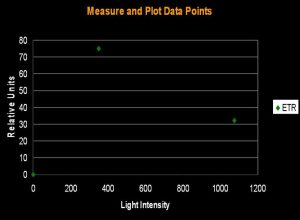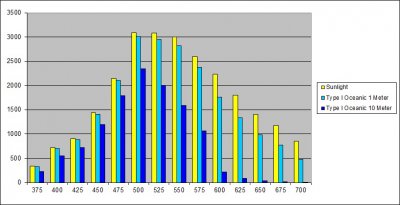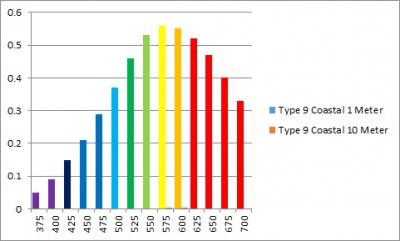Haven't had luck finding any. Does anyone know if PAR and or PUR has ever been taken on coral out in the wild? Would be awesome to know preferred spectrum for coral based on wild locations. So how much blue for deeper water species. Stuff like that. What does in shaded spots of the reef actually mean. Would save the guessing game hobiests play.
Navigation
Install the app
How to install the app on iOS
Follow along with the video below to see how to install our site as a web app on your home screen.
Note: This feature may not be available in some browsers.
More options
You are using an out of date browser. It may not display this or other websites correctly.
You should upgrade or use an alternative browser.
You should upgrade or use an alternative browser.
Any PAR or PUR measurements from wild corals
- Thread starter BrandonS
- Start date
- Tagged users None
Yup.Haven't had luck finding any. Does anyone know if PAR and or PUR has ever been taken on coral out in the wild? Would be awesome to know preferred spectrum for coral based on wild locations. So how much blue for deeper water species. Stuff like that. What does in shaded spots of the reef actually mean. Would save the guessing game hobiests play.
Feature Article: Spectral Data from a Shallow Hawaiian Tidepool
Dana Riddle previously documented and discussed light intensity of a Hawaiian tidepool versus the home aquarium. Dana continues his light analysis by examining spectral data. What can nature teach us about coral care?
Feature Article: Light Data from a Hawaiian Tidepool
Can we possibly match the amount of natural light in an aquarium?

How Much Light?! Analyses of Selected Shallow Water Invertebrates' Light Requirements - Reefs.com
How Much Light?! Analyses of Selected Shallow Water Invertebrates' Light Requirements - Dana examines the optimal amounts of light required for select stony corals, soft coral and a Tridacna clam, and is intended to complement his previous article 'Too Much Light!' (July 2004).
And another, pretty technical though.
 www.advancedaquarist.com
www.advancedaquarist.com
Feature Article: Too Much Light!
This brief article will present results of an experiment in which a coral was exposed to high intensity artificial light within a setting likely replicated by many reef aquaria. It will also discuss concepts well-established within the world of botanical research -those of the intimate and...
Awesome, thank you!
This fantastic information. Thank you for this experiment and write up!Yup.
Feature Article: Spectral Data from a Shallow Hawaiian Tidepool
Dana Riddle previously documented and discussed light intensity of a Hawaiian tidepool versus the home aquarium. Dana continues his light analysis by examining spectral data. What can nature teach us about coral care?www.advancedaquarist.com
Feature Article: Light Data from a Hawaiian Tidepool
Can we possibly match the amount of natural light in an aquarium?www.advancedaquarist.com

How Much Light?! Analyses of Selected Shallow Water Invertebrates' Light Requirements - Reefs.com
How Much Light?! Analyses of Selected Shallow Water Invertebrates' Light Requirements - Dana examines the optimal amounts of light required for select stony corals, soft coral and a Tridacna clam, and is intended to complement his previous article 'Too Much Light!' (July 2004).www.advancedaquarist.com
I know this presents tremendous logistical difficulty, but has any similar information been collected at deeper reefs. Or any calculations for the spectrum stripping effect of water. What we are told is that red and green spectrum is quickly eaten up by water depth. Any way to guess what spectrum values would be at various depths?
Let me find some of the spectral data generated by Jerlov.
Awesome stuff! Thank you
When I saw this title, I immediately thought of Dana’s articles he had written about PAR measurements in Hawaii. I recall there being really low PAR on cloudy days and it made me rethink my lighting.
This is great stuff. Could program lighting to ramp up as well as change spectrum. Also makes a case for running more blues dependant upon what type of coral you keep. Match this with collection depth of said coral and your set!
Thank you so much for the information, study and the help tracking it down.
Thank you so much for the information, study and the help tracking it down.
- Joined
- Jun 15, 2015
- Messages
- 257
- Reaction score
- 235
No wonder when i see videos/documentaries about reefs on TV and internet the underwater ambient color i see is really green, not really pure blue we light our tanks.
The charts above do prove this.
The charts above do prove this.
With the new radions coming out this got me thinking what we actually want our light to be for coral. What better standard then nature.
U
User1
Guest
View BadgesI've seen a rather large brain coral grown in a F-4U Corsair wreck at 114 feet in Hawaii...clearly it was getting something. Also a lot of other stone type corals around the external body of the wreck, engine, etc. Nothing else around but sand and garden eels that I could see - vis was about 100 feet that day.
Anyway glad Dana provided data. I was going to say search for posts by him because there are a few along with threads on the topic.
Anyway glad Dana provided data. I was going to say search for posts by him because there are a few along with threads on the topic.
I mean, if your current spectrum is growing corals and you like the color who cares what silly nature is doing you do you bro. I for one won't be switching to blue green and red yellow light even if my corals double in size daily lolWith the new radions coming out this got me thinking what we actually want our light to be for coral. What better standard then nature.
I agree to a certain extent. My favorite tidepool in Hawaii was filled with beautiful stony corals but their growth was stunted by excessive light and ultraviolet radiation. Fortunately, UV in an aquarium isn't an issue with LEDs and properly shielded metal halide lamps. Intensity, however, is still an issue. But, yes, nature is a standard, we just have to know what to mimic.With the new radions coming out this got me thinking what we actually want our light to be for coral. What better standard then nature.
Similar threads
- Replies
- 3
- Views
- 382
- Replies
- 17
- Views
- 778
- Replies
- 8
- Views
- 136
New Posts
-
When did the BUYER become responsible for shipping delays?
- Latest: EeyoreIsMySpiritAnimal
-
-
-
-

















